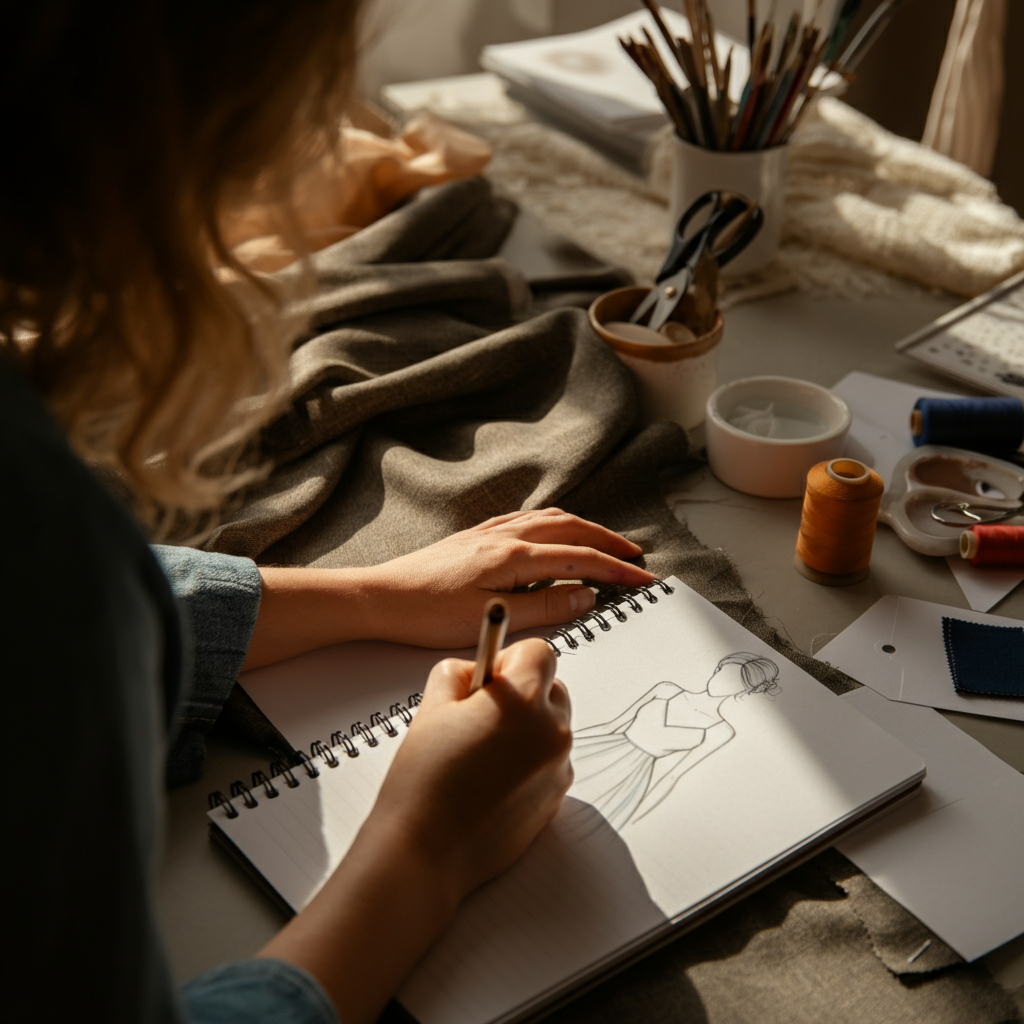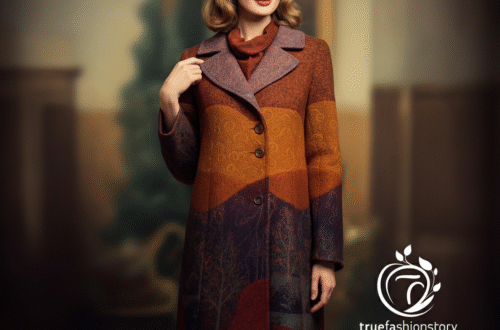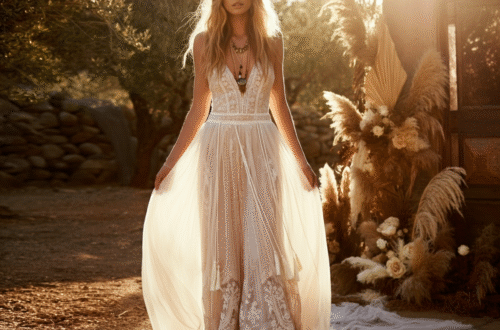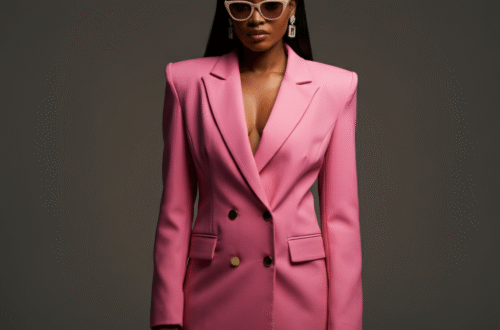Have you ever sketched a dress in your notebook or imagined creating a clothing line everyone wants to wear? A career in fashion design is more than just glamour and runway shows. It’s a path filled with creativity, hard work, and a deep understanding of art and business. This guide will walk you through the essential steps on how to become a fashion designer, from honing your skills to launching your career. We will cover everything from the education you might need to building a standout portfolio that gets you noticed.
This journey requires passion and dedication. You’ll learn to translate your creative visions into wearable art, understand the technical side of garment construction, and navigate the competitive fashion industry. Whether you dream of haute couture or accessible ready-to-wear, the principles of good design and smart business planning are your foundation for success.
Key Takeaways
- Develop Core Skills: Focus on essential skills like drawing, sewing, pattern-making, and understanding textiles.
- Education is Valuable: While not always required, a degree in fashion design provides structured learning, technical training, and industry connections.
- Build a Strong Portfolio: Your portfolio is your professional calling card. It must showcase your unique style, technical abilities, and creative process.
- Gain Practical Experience: Internships and entry-level jobs are crucial for learning the ropes of the industry and building a professional network.
- Understand the Business: Fashion is a business. Learn about marketing, finance, and production to turn your creative passion into a viable career.
Understanding the Role of a Fashion Designer
So, what does a fashion designer actually do? The role is much more than just sketching beautiful outfits. A fashion designer is the creative mind behind clothing, accessories, and footwear. They are involved in the entire process of creating a piece, from the initial concept to the final product. This involves researching trends, selecting fabrics and colors, creating patterns, and overseeing the production of their designs. They must balance artistic vision with commercial viability, ensuring their creations are not only beautiful but also appeal to their target audience and can be produced within a budget.
Designers often specialize in a particular area, such as womenswear, menswear, children’s clothing, or accessories. They might work for large fashion houses, retail chains, or start their own labels. No matter the path, a designer must be a keen observer of culture, art, and society to create collections that feel fresh and relevant. They are storytellers who use fabric and thread as their medium. You can explore different designer journeys and styles at truefashionstory.comBlog.
Core Responsibilities and Daily Tasks
A fashion designer’s day is rarely the same. It is a dynamic mix of creative and practical tasks.
- Market Research: Identifying future trends, themes, and target demographics.
- Conceptualization: Developing a theme or concept for a collection.
- Sketching: Drawing initial designs, either by hand or with computer-aided design (CAD) software.
- Fabric and Material Sourcing: Selecting appropriate textiles, trims, and embellishments.
- Pattern Making and Draping: Creating the technical blueprints for garments.
- Prototyping: Overseeing the creation of sample garments (prototypes) to test the design.
- Fittings: Working with models to check the fit and drape of a garment, making adjustments as needed.
- Production Management: Collaborating with manufacturers to ensure the final collection is produced correctly.
Essential Skills for an Aspiring Fashion Designer
To succeed in fashion, you need a blend of creative talent and practical skills. While a unique artistic vision is crucial, it’s the technical know-how that will bring your ideas to life. Think of it as being both an artist and an engineer. You need the imagination to dream up an innovative design and the technical skill to construct it perfectly. These abilities are the foundation upon which you will build your career.
Developing these skills takes time and practice. Many aspiring designers spend years perfecting their craft before they even think about launching a collection. Start by focusing on one skill at a time, like sketching, until you feel confident. Then move on to the next, like sewing. Over time, you will build a well-rounded skill set that makes you a versatile and capable designer, ready to tackle any creative challenge.
Creative and Artistic Skills
These are the innate talents that often draw people to fashion in the first place.
- Strong Drawing and Sketching: You must be able to communicate your ideas visually. Your sketches need to clearly show the shape, details, and flow of a garment.
- Excellent Sense of Style and Color: Understanding color theory and how different shades work together is fundamental. A good designer knows how to create a mood and tell a story through their color palette.
- Creativity and Imagination: The ability to think outside the box and generate original ideas is what sets a designer apart. This involves finding inspiration in unexpected places.
- Attention to Detail: From the stitching on a seam to the placement of a button, small details can make or break a design. A sharp eye is non-negotiable.
Technical and Practical Skills
These are the hands-on skills that turn a sketch into a wearable piece of clothing.
- Sewing and Garment Construction: You need to know how clothes are put together. Understanding sewing techniques, seams, and finishes is essential for creating quality garments.
- Pattern Making: This is the process of creating the template for a design. Whether you do it by hand or using software, accurate pattern making is key to a good fit.
- Draping: This involves creating a design by pinning and draping fabric directly onto a mannequin. It’s a more three-dimensional approach to design.
- Textile Knowledge: You should be familiar with different types of fabrics, their properties, and how they behave. Choosing the right fabric is critical to a design’s success.
- CAD Software Proficiency: Many designers now use software like Adobe Illustrator and Photoshop to create technical drawings and design mockups.
Educational Paths to Becoming a Fashion Designer
While some famous designers are self-taught, a formal education can provide a significant advantage. Fashion school offers a structured environment to learn technical skills, explore your creativity, and build a network of contacts. It provides a dedicated time to experiment and develop your unique design voice under the guidance of experienced instructors. Moreover, a degree can open doors to internships and job opportunities that might otherwise be difficult to access.
Choosing the right program depends on your career goals. Some schools are known for their focus on avant-garde creativity, while others excel in technical training or the business side of fashion. Research different institutions and their alumni to see which path aligns with your aspirations. Remember, your education is an investment in your future, providing you with the tools and knowledge needed to navigate the competitive fashion world.
Formal Education: Degrees and Diplomas
Most aspiring designers pursue an Associate’s or Bachelor’s degree in Fashion Design or a related field. These programs typically cover:
- Art history and fashion history
- Drawing and illustration
- Color theory
- Pattern making and draping
- Sewing and construction techniques
- CAD for fashion design
- Portfolio development
- The business of fashion
Self-Taught vs. Formal Education
Deciding between formal education and a self-taught path is a personal choice. Here’s a comparison to help you weigh the options:
|
Feature |
Formal Education |
Self-Taught Path |
|---|---|---|
|
Structure |
Curriculum-based, with deadlines and expert guidance. |
Flexible, self-directed learning. Requires immense discipline. |
|
Resources |
Access to industrial sewing machines, dress forms, and labs. |
Must acquire all tools and resources independently. |
|
Networking |
Built-in connections with professors, peers, and industry guests. |
Networking must be done proactively through events and online. |
|
Credibility |
A degree from a reputable school can add weight to a resume. |
Credibility is built entirely through the strength of the portfolio. |
|
Cost |
Can be very expensive (tuition, materials, living costs). |
Lower initial cost, but may require investment in courses/workshops. |
Alternative Learning: Workshops and Online Courses
If a full degree program isn’t feasible, don’t worry. There are many other ways to learn the necessary skills. Community colleges, art centers, and even fabric stores often offer workshops on sewing, pattern making, and other essential techniques. Additionally, the internet is a treasure trove of resources. Online platforms offer courses on everything from fashion illustration to digital design, often taught by industry professionals. These alternatives allow you to learn at your own pace and can be a great way to supplement your skills or test the waters before committing to a degree. For more insights on building a fashion career, check out the resources at truefashionstory.comBlog.
Building a Killer Fashion Portfolio
Your portfolio is the single most important tool in your job search. It’s a visual resume that showcases your talent, skills, and unique point of view as a designer. It should tell a compelling story about who you are and what you can create. A strong portfolio does more than just display pretty pictures; it demonstrates your entire design process, from the initial spark of inspiration to the finished garment. It should be well-organized, professional, and tailored to the specific job or school you are applying to.
When assembling your portfolio, think about quality over quantity. It’s better to have a few stellar projects that are fully developed than a dozen mediocre ones. Each project should include your inspiration (mood boards), initial sketches, fabric swatches, technical drawings (flats), and high-quality photos of the final garments, preferably on a live model. This comprehensive approach shows that you understand the entire design lifecycle and can execute a vision from start to finish.
What to Include in Your Portfolio
A strong portfolio should be a curated collection of your best work. Include:
- Inspiration/Mood Boards: Show your thought process and the story behind your collection.
- Sketches and Illustrations: Display your drawing skills and initial ideas.
- Technical Flats: These are detailed, two-dimensional drawings that show the construction of a garment.
- Fabric and Color Palettes: Include swatches of the materials you used.
- Photos of Finished Garments: High-quality images of your work, ideally on models, are essential.
- Personal Projects: Include any work that highlights your unique style, even if it wasn’t for a class.
Digital vs. Physical Portfolios
In today’s world, you will likely need both a physical and a digital portfolio. A physical portfolio is impressive in an in-person interview, allowing interviewers to see the quality of your work up close. A digital portfolio, often in the form of a personal website or a PDF file, is essential for online applications and reaching a wider audience. Your website should be clean, professional, and easy to navigate, with high-resolution images of your work. Having both ensures you are prepared for any opportunity that comes your way.
Gaining Real-World Experience
Experience is invaluable in the fashion industry. Internships, apprenticeships, and entry-level positions provide a behind-the-scenes look at how the industry truly operates. This hands-on experience is where you’ll learn the practical skills that can’t be taught in a classroom. You’ll understand the fast-paced nature of the fashion calendar, the importance of teamwork, and the realities of production and deadlines. These experiences are also your best chance to start building a professional network, which is critical for long-term success.
Don’t be afraid to start at the bottom. Whether you’re fetching coffee, organizing fabric swatches, or assisting in a design studio, every task is a learning opportunity. The connections you make and the reputation you build as a hard-working, reliable team member will be incredibly valuable as you advance in your career. Many top designers started their careers with internships, using them as a stepping stone to full-time positions.
The Importance of Internships
Internships are your ticket into the industry. They allow you to:
- Apply your classroom knowledge in a professional setting.
- Learn from experienced designers and industry veterans.
- Build a network of professional contacts.
- Gain valuable experience to add to your resume.
- Potentially secure a full-time job offer after graduation.
Finding Entry-Level Positions
Once you have some experience and a solid portfolio, you can start looking for entry-level jobs. These roles might include Assistant Designer, Technical Designer, or Production Assistant. Use online job boards, your school’s career services, and your professional network to find openings. Be persistent and tailor your application to each company. Highlight the skills and projects from your portfolio that are most relevant to the job description.
Launching Your Fashion Career
With your education, skills, and portfolio in place, it’s time to officially launch your career. This can mean seeking employment with an established brand or taking the entrepreneurial route and starting your own label. Both paths have their own set of challenges and rewards. Working for a brand offers stability, mentorship, and the chance to learn the business from the inside. Starting your own line offers complete creative freedom but requires strong business acumen and financial resources.
Your early career is a time for growth and learning. Be open to different opportunities, even if they aren’t your dream job right away. Every role will teach you something new about the industry. Continue to refine your skills, update your portfolio, and network with other professionals. The fashion world is constantly evolving, and your ability to adapt and grow will be key to your long-term success.
Working for a Fashion House
Joining an established company is a common path for new designers. You’ll work as part of a team, contributing to collections under the guidance of a creative director. This is an excellent way to learn about the entire supply chain, from design and manufacturing to marketing and sales.
Starting Your Own Label
If you have a strong entrepreneurial spirit and a clear vision, you might consider starting your own fashion brand. This path requires more than just design skills; you’ll also need to be a businessperson. You’ll need a solid business plan, funding, and a deep understanding of your target market. It’s a challenging but potentially very rewarding journey.
Conclusion
Becoming a fashion designer is a marathon, not a sprint. It requires a unique combination of raw creativity, technical proficiency, and business sense. The journey begins with building a strong foundation of skills in sketching, sewing, and pattern making. A formal education can provide structure and connections, but a passion for learning and relentless practice are what truly matter. Building a standout portfolio is your next critical step, as it will be your key to unlocking opportunities.
Gaining real-world experience through internships will give you an invaluable look into the industry’s inner workings and help you build a network of contacts. Whether you choose to work for an established brand or bravely launch your own, your success will depend on your dedication, resilience, and unwavering passion for design. Embrace the process, stay curious, and never stop creating. Your unique voice is waiting to be seen and worn.
Frequently Asked Questions (FAQ)
Do I need to be good at drawing to be a fashion designer?
Yes, drawing is a fundamental skill. You need to be able to visually communicate your design ideas clearly through sketches. However, you don’t need to be a fine artist; the focus is on clear, proportional fashion illustration.
How long does it take to become a fashion designer?
The timeline varies. A bachelor’s degree typically takes four years. After that, it can take several more years of internships and entry-level jobs to work your way up to a designer position.
Can I become a fashion designer without going to fashion school?
Yes, it is possible. Designers like Coco Chanel were self-taught. However, it requires immense self-discipline, a commitment to learning technical skills independently, and a very strong portfolio to compete with those who have formal training.
How much do fashion designers make?
Salaries can vary widely based on experience, location, and the company you work for. According to the U.S. Bureau of Labor Statistics, the median annual wage for fashion designers was $77,450 in May 2021, but entry-level salaries will be lower.
What is the most important skill for a fashion designer?
While many skills are important, creativity and a unique vision are arguably the most crucial. Technical skills can be learned, but a distinct creative voice is what will make you stand out in a competitive industry.




